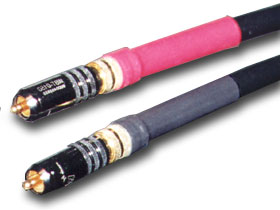![[SoundStage!]](../titles/sslogo3.gif) Home
Audio Home
Audio Equipment Review |
|||||||||||||||||||
May 2000 Nirvana Audio S-X Ltd. Interconnectsby Jeff Fritz
The cable The Nirvana S-X Ltd. under evaluation here is based on the company's S-L interconnect. According to the company’s founder and chief designer, Steven Creamer, the S-X Ltd. is actually an extreme version of that highly successful cable, as the basic design is very similar. The S-X Ltd. uses symmetrical-Litz geometry with 95 isolated strands per conductor. Material is of a high quality, as you would expect at the $1495-per-1.5-meter-length price. Aerospace-grade insulation is used, as is silver solder. The RCAs are locking WBT connectors, which really grab onto input jacks; however, Nirvana is working on its own custom locking RCA connector for the cable. The recommended burn-in period is a minimum of 40 hours. According to Creamer, the S-X Ltd. offers a "more open, transparent, detailed" sound along with a lowered noise floor compared with his other cables. The S-X Ltd. is optimized for the "delicate signal" transferred between source component and preamp, and that is how it was evaluated in my system. The review system My review system has undergone a few changes throughout the past year. First, my dedicated listening room was replaced with what my wife would tell you is a "listening house." She says this because my system now resides in the largest open space in my abode, and the components in it are not what you would call subtle. The main speaker system is the Wilson X-1 Grand SLAMM Series II coupled with the Wilson XS subwoofer. The ancillary equipment used during this evaluation period included my reference Coda 04r line-stage preamp, Simaudio W-5 amplifier and most recently a Jeff Rowland 8T amplifier. The Pioneer 606D DVD player continues to be my digital rig of choice until the universal transports hit the market later this year (hopefully!). Cables were my usual fare of Harmonic Technology Pro-9 speaker cables and Transparent Audio Super interconnects. The sound There was one area that I would declare a significant improvement with the Nirvana cable installed. It was easily heard, and took no more than about 30 minutes to detect clearly. Images within the soundstage became more focused and coherent. There were clear outlines around performers that were a little more vague with the Transparent cable installed. Vocalists became more precisely centered and had less image wander. This was surprising to me as I expected the tonal balance or the frequency spectrum to change slightly as a result of a cable change. This was not the case, though. In fact, I could not detect any improvement or degradation in areas of frequency response or tonal accuracy.
The increased precision with which the soundstage was presented might make one think that microdynamics were improved as well. This was true to an extent, which would support Creamer's claim that low-level signals are preserved better with this cable. Images were presented with lifelike size and solidity. This was observed on many recordings, including the Braveheart soundtrack [DECCA 448 295-2]. When listening to a recording with stunning dynamic contrasts, the Nirvana cable became a welcome addition due to its ability to preserve the ebb and flow of the music. Everything remained in its place at all times. The precision helped me track the music, which was thrilling! I did not detect any anomalies due to the inclusion of the Nirvana cable in my system. This is good as it means the only areas affected were of a positive nature. It does not mean that all areas of performance were improved, however. Another recording that proved valuable, not to mention enjoyable, was James Carter’s Conversin’ with the Elders [Atlantic 82908-2]. This is a fair recording that amply displays low-level-detail and frequency-response anomalies. The Nirvana S-X Ltd. remained faithful to the source. Comparisons This is where the story gets a little tricky. There are areas where some lower-priced cables equal the Nirvana S-X Ltd. The Harmonic Technology Pro-Silway MK II ($399 for a one-meter pair) equals the overall crystalline clarity of the Nirvana cable. Both of these top-notch performers better the Transparent Super when it comes to high-frequency air and neutrality. In fact, throughout the frequency range, these cables actually sound fairly similar with respect to tonality and extension at the extremes. The Nirvana nudges ahead with its precision, but not in a monumental way. It should be noted that the Harmonic Technology cables offer performance that belies their price. As you get better gear, the point of diminishing returns can kick in unexpectedly. The Harmonic Technology cables as well as the Nirvana S-X Ltd. are both excellent performers, bettering my long-term reference from Transparent Audio. The S-X Ltd. only betters the Pro-Silway Mk II in the areas of soundstage precision and image coherency. In the end, that’s what the extra thousand dollars buys you. For many, it will be a worthwhile upgrade. Conclusion The Nirvana S-X Ltd. is the best interconnect I have had in my system. It betters the other cables I’ve tried in some important areas. If you value the ability to locate precisely the players within a performance, the Nirvana cable may be a revelatory upgrade. If you are looking for enhanced extension at the extremes or tonal purity, it can be equaled for less money. Of course, a home audition is warranted, as these results will vary with a different set of associated components. The S-X Ltd. is a very good product with strengths that are obvious and rewarding. ...Jeff Fritz
|
|||||||||||||||||||
|
|||||||||||||||||||
![[SoundStage!]](../titles/sslogo3.gif) All
Contents All
ContentsCopyright © 2000 SoundStage! All Rights Reserved |
